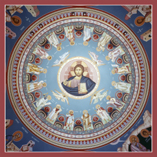 Particular Characteristics of Icons Particular Characteristics of Icons
Icons and Time
Read typical hagiographical icons (icons with indivual scenes of a saint’s life) in a circle from top left corner to the right.
On icons that do not feature distinct individual scenes, events that happened at different actual historical
times but which relate to each other are sometimes shown together. These snapshots of
events (called ‘arrested development’) imply action but are frozen in time.
Stylistic Features of Icons
Thin faces and small arms show the effects of physical suffering that actually symbolize spiritual suffering in some individuals.
Buildings are used to place the scene’s location but are not drawn proportionally.
In the two-dimensional images classical (Roman/Greek) clothing and style is often used (curly hair, ribbons in the hair of women).
Natural and supernatural things such as rivers and ‘death’ are sometimes personified by a small figure (such as the ‘river god’ in the Jordan fleeing Christ’s blessing).
The Lord Jesus and the Theotokos
Christ is typically shown in classical/hellenic clothing: a chiton (tunic) with wide sleeves adorned with clavi (purple or gold bands). Over this is worn a himation (large mantle/cloak) which is usually blue and that often is made to appear to shine with Christ’s inner spiritual life. He is not shown in the clothing of royalty.
The golden halo that surrounds the head of saints showing the uncreated light of Christ (‘Taborite light’) that is part of them and radiates from them
is modified so that Christ's halo contains a cross and/or lettering to allude to the Trinity.
The Virgin Mary wears a maphorion (large veil that is usually ‘imperial purple’ in color) that covers her from head to feet. Underneath is a simple dress. Her head is covered with a coif (a skullcap) that hides her hair. Like Christ, she is never shown in royal attire.
Saints and Angels
Angels are dressed royally since they represent the power of God. Some have a white cloak and chlamys (cloak joined at the shoulder which a royal court chamberlain would wear). Sometimes they have armor and weapons to show their power and some wear a long white jeweled scarf (loros) worn by Byzantine emperors at Easter which alludes to the winding sheet and resurrection.
Saints are shown in royal attire reflecting their presence in heaven. Martyrs and virgins often wear white for purity.
Bishops prominently wear an omophorium (black and white stole with crosses).


|